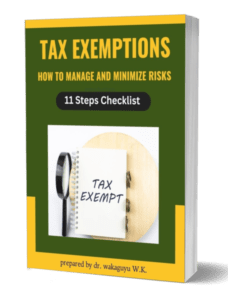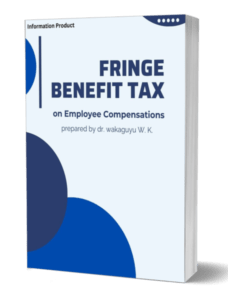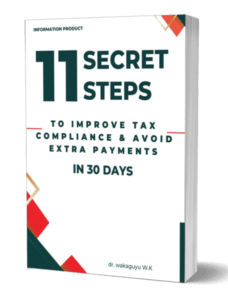Many arguments exist about religious organizations’ tax exemptions because of their social contributions and religious organizations’ government separation. The fundamental question revolves around whether religious organizations should be exempted from taxes and how to balance economic impact, community involvement, nonprofit status, and religious freedom.
a. Affiliate Disclosure: These are affiliate links from which we receive a commission at no cost. Read the full Affiliate marketing disclosure HERE.
b. Tax Contents Disclaimer: The tax industry in Kenya is very dynamic. The tax contents of the posts are not professional advice. Read the full disclosure HERE.
This mix is an example of a bigger problem: balancing creating an environment that acknowledges and supports the positive social contributions of religious organizations and constitutional objectives.
In the following sections, we explore the main issue, the problem, the solution, and the steps to implement the recommended solution. The steps are multifaceted strategies to navigate this complex interplay.
Table of Contents
What is the Issue?
The issue concerns the principle of separation of religion and state and the aspiration to acknowledge and compensate religious establishments for their contributions to the community. The challenge stems from religious freedom, community services, nonprofit status, and financial implications.
What is the Problem?
The major problem is whether religious organizations should be exempt from taxes. This is because of factors such as the separation of religious organizations and states, the social and charitable contributions made by religious organizations, the religious organizations being nonprofits, and concerns about the potential adverse effects of taxing the religious organizations on the local economy.
The Solution
The solution is to establish clear rules and oversight for tax exemptions. This would restrict political activity, link exemptions to community benefits, implement regular reviews, promote public discourse, and conduct analyses necessary for a comprehensive solution.
In the following section, we explore 11 steps to resolve the conflict between the principle of separation of religion and state and the aspiration to acknowledge and compensate religious establishments.
11 Steps to Implement the Solution
The following eleven steps can be adapted to achieve the solutions:
1. Laws and Regulations:
Draft laws and regulations that consider community service, financial transparency, and adherence to constitutional principles. The establishment of the legal frameworks will ensure tax exemptions are awarded in a transparent, goal-aligned, and equitable way.
2. Oversight Mechanisms:
To ensure the regulations are followed and enforced, there is a need to develop robust monitoring systems. These require establishing oversight organizations that can audit religious organizations, ensure they abide by the laws and regulations, and investigate any potential abuse of the tax-exempt status. Effective oversight is necessary to maintain the integrity of the tax-exemption system and prevent any misuse of the privileges.
3. Financial Transparency:
Stringent guidelines should be provided regarding transparency for religious organizations seeking tax exemptions. The financial accounts for the organizations should be made publicly available, regular financial audits conducted, and accepted accounting standards followed. Financial transparency will assist the public and other stakeholders in understanding how religious organizations manage the resources intended for charitable and community service.
4. Political Activities:
There is a need for clear guidelines on the political activities of tax-exempt religious organizations. This will stop the organizations from unduly influencing political processes and ensure they are politically neutral to focus on their intended religious and humanitarian efforts.
5. Tangible Community Benefit:
Define and implement guidelines that link tax exemptions to tangible benefits for the community. This encourages religious organizations to participate proactively in charitable and volunteer work that benefits society. This will also reinforce the notion these organizations tackle societal challenges and that tax-exempt status is granted only after demonstrable good results.
6. Periodic Assessment:
Establish a system for regular assessments to ascertain whether the religious organizations meet the tax exemption requirements. The assessments will allow the organizations to adapt to evolving circumstances and ensure their growth is aligned with community needs.
7. Public Engagement:
To get feedback from numerous stakeholders, hosting meetings, forums, or open consultations to promote public participation is required. Through this engagement, the regulations governing tax exemptions for religious organizations are placed in the community’s hands. Including the community in decision-making promotes understanding, addresses issues, and builds consensus, all of which help create a more informed and equitable regulatory framework.
8. Education and Outreach:
Implement outreach initiatives and educational programs to inform relevant parties, the public, and religious organizations on any new laws or changes to tax-exemption policy. This proactive approach guarantees adherence to the guidelines, increases awareness, and fosters a shared understanding of the expectations placed on religious organizations.
9. Capacity Building:
Increase capacity in religious organizations in areas like budgetary control and compliance with transparency rules by providing them with tools and guidance. This can be done through partnerships with relevant organizations, training sessions, or workshops. This will make it easier for religious organizations to successfully fulfil their missions of giving to the community and charity.
10. Incentives for Compliance:
Consideration should be given to reward religious organizations that go above and beyond the requirements to be eligible for tax exemptions. This could include additional benefits or acknowledgement of exceptional volunteer work, original ideas, or transparent bookkeeping practices.
11. Feedback Mechanisms:
For stakeholders and the public to provide input on how religious groups are doing about their tax-exempt status, formal feedback channels should be established. This two-way communication not only encourages accountability and helps identify potential issues but also creates a responsive structure that can quickly address any complaints.
By taking these steps, issuing tax exemptions to religious organizations can be reinforced, made more transparent, and adaptable to the organizations’ and communities’ changing needs.
Conclusion
Religious organizations’ tax exemptions are tricky. The proposed solution balances religious organizations’ state separation with their social responsibilities through oversight systems, transparency requirements, and community benefit criteria.
A flexible regulatory structure is needed due to the economic implications, the delicate balance between religious freedom and accountability, and the increasing role of religious organizations in our society.
Public involvement, education, and compliance incentives can strengthen this framework and encourage transparency. By acknowledging religious organizations’ benefits and addressing financial transparency and political neutrality, we may build a sound regulatory environment that benefits society.
Thank you for reading the post.
dr. wakaguyu W.K






